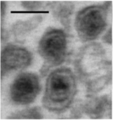Microvesicle
Microvesicle
A Microvesicle is a type of extracellular vesicle that is released from the cell during cell activation or apoptosis. They are typically 100-1000 nanometers in diameter and contain various types of cellular materials including proteins, lipids, and nucleic acids.
Formation[edit]
Microvesicles are formed through the outward budding and fission of the plasma membrane. This process is distinct from the formation of other types of extracellular vesicles, such as exosomes, which are formed within the cell and then released. The formation of microvesicles is often triggered by cellular stress or activation signals.
Composition[edit]
The composition of microvesicles can vary depending on the type of cell from which they originate. They typically contain a variety of cellular materials, including proteins, lipids, and nucleic acids. Some microvesicles also contain cytosolic components, such as enzymes or cytoskeletal proteins.
Function[edit]
Microvesicles play a role in a variety of biological processes. They can facilitate cell-to-cell communication by transferring their contents from one cell to another. They can also contribute to the spread of disease, as some viruses and bacteria can use microvesicles to transfer their genetic material between cells. In addition, microvesicles can have a role in immune response, coagulation, and inflammation.
Clinical significance[edit]
Microvesicles have been implicated in a variety of diseases, including cancer, cardiovascular disease, and neurodegenerative diseases. They can serve as biomarkers for these and other diseases, as changes in their number or composition can indicate disease presence or progression. In addition, microvesicles are being explored as potential therapeutic targets or vehicles for drug delivery.
See also[edit]

This article is a cell biology stub. You can help WikiMD by expanding it!
-
Microvesicle
-
Microvesicle
Ad. Transform your life with W8MD's Budget GLP-1 injections from $75


W8MD offers a medical weight loss program to lose weight in Philadelphia. Our physician-supervised medical weight loss provides:
- Weight loss injections in NYC (generic and brand names):
- Zepbound / Mounjaro, Wegovy / Ozempic, Saxenda
- Most insurances accepted or discounted self-pay rates. We will obtain insurance prior authorizations if needed.
- Generic GLP1 weight loss injections from $75 for the starting dose.
- Also offer prescription weight loss medications including Phentermine, Qsymia, Diethylpropion, Contrave etc.
NYC weight loss doctor appointmentsNYC weight loss doctor appointments
Start your NYC weight loss journey today at our NYC medical weight loss and Philadelphia medical weight loss clinics.
- Call 718-946-5500 to lose weight in NYC or for medical weight loss in Philadelphia 215-676-2334.
- Tags:NYC medical weight loss, Philadelphia lose weight Zepbound NYC, Budget GLP1 weight loss injections, Wegovy Philadelphia, Wegovy NYC, Philadelphia medical weight loss, Brookly weight loss and Wegovy NYC
|
WikiMD's Wellness Encyclopedia |
| Let Food Be Thy Medicine Medicine Thy Food - Hippocrates |
Medical Disclaimer: WikiMD is not a substitute for professional medical advice. The information on WikiMD is provided as an information resource only, may be incorrect, outdated or misleading, and is not to be used or relied on for any diagnostic or treatment purposes. Please consult your health care provider before making any healthcare decisions or for guidance about a specific medical condition. WikiMD expressly disclaims responsibility, and shall have no liability, for any damages, loss, injury, or liability whatsoever suffered as a result of your reliance on the information contained in this site. By visiting this site you agree to the foregoing terms and conditions, which may from time to time be changed or supplemented by WikiMD. If you do not agree to the foregoing terms and conditions, you should not enter or use this site. See full disclaimer.
Credits:Most images are courtesy of Wikimedia commons, and templates, categories Wikipedia, licensed under CC BY SA or similar.
Translate this page: - East Asian
中文,
日本,
한국어,
South Asian
हिन्दी,
தமிழ்,
తెలుగు,
Urdu,
ಕನ್ನಡ,
Southeast Asian
Indonesian,
Vietnamese,
Thai,
မြန်မာဘာသာ,
বাংলা
European
español,
Deutsch,
français,
Greek,
português do Brasil,
polski,
română,
русский,
Nederlands,
norsk,
svenska,
suomi,
Italian
Middle Eastern & African
عربى,
Turkish,
Persian,
Hebrew,
Afrikaans,
isiZulu,
Kiswahili,
Other
Bulgarian,
Hungarian,
Czech,
Swedish,
മലയാളം,
मराठी,
ਪੰਜਾਬੀ,
ગુજરાતી,
Portuguese,
Ukrainian

